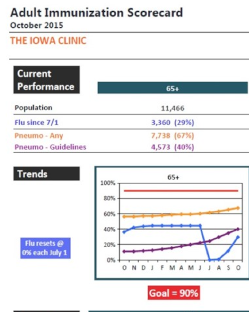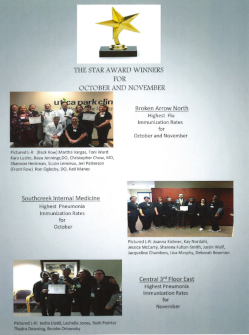Financial Management: Level 3
Align compensation with performance on immunization metrics
Align compensation with performance on immunization metrics to help your organization move vaccination activities beyond small, ad hoc projects to broader strategic initiatives. Garner stakeholder support for compensation changes early in the process to foster acceptance. Establish clear immunization goals, communicate them to relevant team members, and provide regular updates on progress and milestones achieved.
Performance-based incentives typically average around 10%-20% of total compensation. While providers are accustomed to being compensated this way, best practices recommend extending performance-based incentives to other members of the care team. By incorporating immunization metrics into an organization’s compensation plan, you can foster team-based care and shared accountability for improving routine adult immunization rates.
Consider the following tips and best practices as you work to align compensation with performance on immunization metrics.
Engage stakeholders early in the process
Engage the strategic planning, quality, and compensation committees early to establish support for inclusion of immunization metrics in incentives and later to secure agreement on immunization goals. Enlist the Chief Medical Officer or Chief Quality Officer to help advocate with the Chief Executive Officer, Chief Financial Officer, and Chief Operating Officer for relevant immunization quality measures to be included in your organization’s annual strategic planning process and ultimately in the strategic plan.
Set clear and impactful goals
To ensure your goals are clear and impactful, consider the following activities:
- Define the work team and whose compensation will be impacted by immunization metrics. In some organizations, similar incentives are established at a system level; other healthcare organizations create individual goals tracked by provider.
- Determine what portion of incentives will be contingent on immunization metrics. Performance-based incentives typically account for approximately 10%-20% of total compensation.
- Consider a phased implementation with compensation incentives that start small in the first year or two and then gradually increase.
- Start with high-impact areas when determining metrics, like the campaign bundle measure or pneumonia vaccination for patients age 65+.
- Account for tracking challenges associated with immunizations (e.g., seasonal immunizations like influenza that “start over” each year).
Consider the full meaning of compensation
There are many types of rewards for meeting metrics and delivering value beyond incentive-based percentages of a core salary. Also consider bonuses, extra paid time off, small prizes, and recognition through activities (e.g., awards, lunches) and internal communications (e.g., newsletters, letters of recognition).
Clearly communicate with relevant team members
Clearly communicate the organization’s immunization goals as well as incentives available to employees who meet the goals. Be sure to:
- Establish a baseline for performance on immunizations and make all relevant team members aware of the baseline.
- Regularly communicate updates and milestones achieved through an employee intranet, an internal dashboard, or a scorecard.
- Provide ongoing education to ensure a continued focus on meeting immunization goals.

Adult Immunization Scorecard
The Iowa Clinic, P.C.
Displays immunization goals and rates at an organizational and clinic level. This scorecard communicates to staff performance on immunization metrics that are tied to compensation.
View Tool
Annual Immunization Star Award Winners
Utica Park Clinic
Recognizes recipients of the Annual Immunization Star Award, which celebrates staff with the highest immunization rates. The presentation of this award and internal communications about the recipients was used to reward high-performing staff who met or exceeded immunization goals.
View ToolCampaign Planks
Provider & Staff Education
Clinical Support
IT / Documentation
Patient Education
